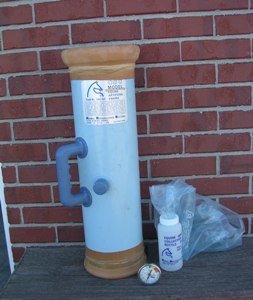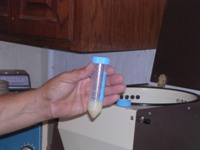Horse Semen Collection
Egyptien S, Deleuze S, Ledeck J, Ponthier J. Egyptien S, et al. Animals (Basel). 2023 Oct 6;13(19):3123. doi: 10.3390/ani13193123. Animals (Basel). 2023. PMID: 37835729 Free PMC article. Review.
Biochemistry of stallion semen
Stallion semen has several chemical characteristics not commonly encountered in other animals. It contains very little fructose and the spermatozoa possess only limited fructolytic ability under anaerobic conditions. By determining some of the characteristic constituents such as ergothioneine, citric acid, glycerylphosphorylcholine and certain glycosidases, it is possible to obtain a quantitative measure of the secretory contribution of the ampulla, seminal vesicle and epididymis, respectively, towards the final composition of the whole ejaculate. By analysing separately the various fractions of a split ejaculate, including the so-called tail-end sample, it is possible to detect and pinpoint abnormalities in the functional state of the various male accessory organs and in the entire process of ejaculation.
Similar articles
Kosiniak K. Kosiniak K. J Reprod Fertil Suppl. 1975 Oct;(23):59-61. J Reprod Fertil Suppl. 1975. PMID: 1060850
Sanada S, Arai E, Ueda M, Ogura K, Yoshida O. Sanada S, et al. Hinyokika Kiyo. 1988 Nov;34(11):1965-72. Hinyokika Kiyo. 1988. PMID: 3242371 Japanese.
Simbini T, Umapathy E, Jacobus E, Tendaupenyu G, Mbizvo MT. Simbini T, et al. Urol Int. 1998;61(2):95-100. doi: 10.1159/000030296. Urol Int. 1998. PMID: 9873248
Kareskoski M, Katila T. Kareskoski M, et al. Anim Reprod Sci. 2008 Sep;107(3-4):249-56. doi: 10.1016/j.anireprosci.2008.04.013. Epub 2008 Apr 29. Anim Reprod Sci. 2008. PMID: 18556156 Review.
Vanha-Perttula T, Rönkkö S, Lahtinen R. Vanha-Perttula T, et al. Andrologia. 1990;22 Suppl 1:10-24. Andrologia. 1990. PMID: 2132063 Review.
Cited by
Egyptien S, Deleuze S, Ledeck J, Ponthier J. Egyptien S, et al. Animals (Basel). 2023 Oct 6;13(19):3123. doi: 10.3390/ani13193123. Animals (Basel). 2023. PMID: 37835729 Free PMC article. Review.
Sotgia S, Taras A, Zinellu A, Cherchi R, Mangoni AA, Carru C, Bogliolo L. Sotgia S, et al. Antioxidants (Basel). 2020 Sep 13;9(9):855. doi: 10.3390/antiox9090855. Antioxidants (Basel). 2020. PMID: 32933136 Free PMC article.
Peña FJ, O’Flaherty C, Ortiz Rodríguez JM, Martín Cano FE, Gaitskell-Phillips GL, Gil MC, Ortega Ferrusola C. Peña FJ, et al. Antioxidants (Basel). 2019 Nov 19;8(11):567. doi: 10.3390/antiox8110567. Antioxidants (Basel). 2019. PMID: 31752408 Free PMC article. Review.
MeSH terms
Horse Semen Collection

In collecting semen from a stallion, a jump mare or breeding phantom is commonly used. Stallions can be easily trained to mount a breeding phantom. Those trained to mount a phantom make collection much safer and more consistent. The phantom should be designed to be comfortable for the stallion and should mimic the same angle as the mare. If a jump mare is used, she should be in good standing heat and have her tail wrapped and perineal area washed. Restrain the mare to prevent injury to the stallion or personnel assisting.
An artificial vagina is used to collect the semen for evaluation. Several artificial vaginas are available: the Colorado, Missouri and Japanese models. Selection of an artificial vagina (AV) is determined mainly by management and stallion preference. To prepare the artificial vagina, fill it with water to obtain proper temperature and pressure. Some models use a combination of water and air to get the proper pressure. Because of stallions’ individual natures, water temperature preference, pressure and lubrication will vary. Therefore, it is important to prepare the AV to the personal preference for the stallion being collected.
Colorado AV

Water temperature for the AV is normally between 45 to 48°C. However, water temperature should be governed by the ideal collection temperature for an individual stallion. Avoid higher temperatures to prevent irritation to the stallion’s penis and sperm damage. Lubricate the AV with a sterile, non-spermicidal lubricant just before use. Do not use products detrimental to sperm cells. Use enough lubricant to allow easy penetration with little resistance. Warm the collection bottle and keep it warm during collection to avoid damaging sperm cells.
The stallion should be introduced to the mare and stimulated to let down. Upon stimulation, wash the stallion with clean warm water. Do not use soap or disinfectant to wash the stallion’s penis. The collection area should be large enough to prevent injury to all those involved. Once the stallion has reached full erection, allow him to mount the phantom or mare for collection. The stallion’s penis should be deflected into the AV, not grasped, because some stallions take offense to being grasped. The AV should be held firmly for the stallion to thrust against and should be at the same angle as the mare’s vagina. As the stallion ejaculates, the AV should be lowered to allow the semen to run into the collection bottle. Ejaculation can be determined by watching for the “flagging” motion of the stallion’s tail or by the pulsation of semen passing through the urethra at the base of the penis. Upon completion, drain the water to let the remaining semen drain into the collection bottle. Then keep the semen in an incubator until evaluated.
Care during Collection
Great care is taken during collection to ensure the spermatozoa are in an environment that guards against cold shock and contamination of spermicidal agents. For most stallions, A.V.’s are typically prepared for inner temperatures between 100.0 to 112.0 o Fahrenheit (38 to 45 o C) at the time of collection. Stallions are sensitive to pressure and temperature changes, and accurate monitoring is essential for promoting sex drive.
Non-spermicidal lubricants are used, and spermicides such as water and light are not allowed to come in contact with the ejaculate. Any equipment or materials that come in contact with the spermatozoa are warmed to about 100.0 o Fahrenheit (38 o C). Once extended, semen is housed in an incubator at 100.0 o Fahrenheit (38 o C) until inseminated. Insemination should follow within the hour or as quickly as possible since the longer semen is stored, the greater the loss of live, motile spermatozoa cells.

Semen Post Collection
Recent changes in several major breed registries have allowed for increased use of cooled and frozen semen. Cooling or freezing semen allows for semen to remain viable longer. As such, semen can be shipped to mares, eliminating the cost and stress of shipping a mare and foal. Freshly collected extended semen can be cooled to 40.0 o Fahrenheit, transported in containers specially designed to maintain the cool temperature, and inseminated in mares 24 to 48 hours after collection. The success of using cooled semen depends on how well a particular stallion’s spermatozoa respond to cooling, the synchronization of the mare’s estrus to the time of insemination, and how well proper semen collection and handling techniques are followed.
Although frozen semen is routinely used in other species of livestock, it has not been as well researched in horses because of breed registry restrictions on its use. However, it will become more common because of recent changes adopted by many registries for legalization of its use. Frozen semen is packaged in pellets, plastic straws or glass ampules and stored in liquid nitrogen at temperatures below -320.0 o Fahrenheit.
Semen collection schedules

Collection with a jump mare.
Collecting or breeding once per week decreases the weekly sperm output compared with breeding or collecting daily or every other day. Sperm output per week is similar whether collecting every other day or daily. Therefore, for maximum amounts of sperm collection and minimum labor, stallions should be collected every other day. The every-other-day schedule is typical for farms using artificial insemination.
Managers breeding stallions by natural cover may need them to cover mares more frequently than every other day. More frequent collection intervals will not result in a significant increase in weekly sperm output. Rather, individual collections will have fewer spermatozoa. Whether or not these decreases are significant enough to lessen fertility when breeding every day or twice daily will depend on the stallion’s spermatozoa production capability.
The stallion’s sex drive and his ability to produce spermatozoa will place limits on how often he can successfully breed mares. Sex drive, as monitored by reaction time and number of mounts necessary before ejaculation, usually will not be affected by increasing the breeding frequency from every other day to daily collections. However, managers must treat stallions as individuals and regulate collection intervals appropriately. Overuse can cause decreases in sex drive, observed by the stallion’s disinterest in breeding, longer mounting times required before breeding, or lack of ejaculation during breeding.
]]>